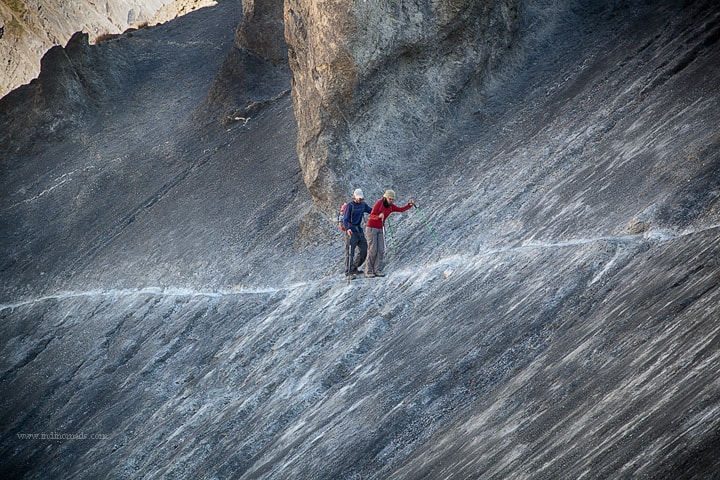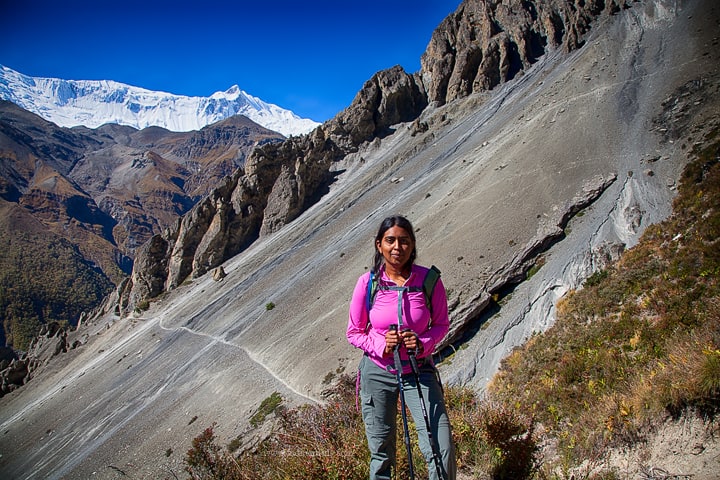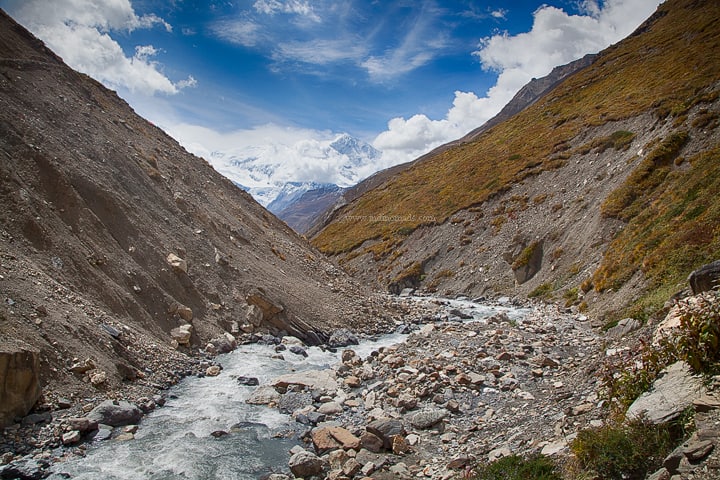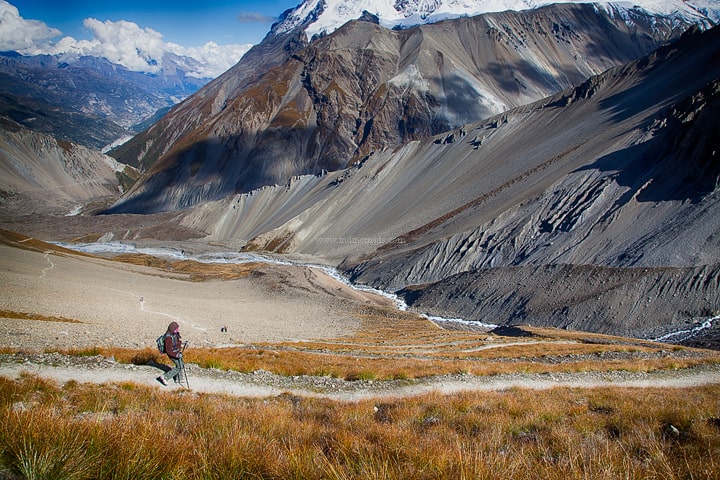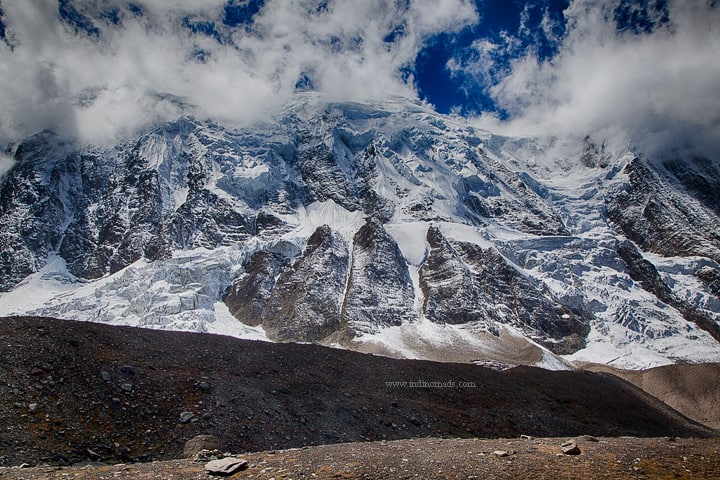Tilicho lake trek is one among 100s stunning and strenuous treks you can possibly attempt in the Nepal Himalayas. Due to the fact Tilicho lake trek is part of the popular Annapurna Circuit, the tilicho trek has been lot of attention from fellow hikers. Yet, the trek to Tilicho lake is probably only attempted by fewer people compared Annapurna Circuit.
My husband and I had two months in hand for trekking in Nepal and we decided to fill it up with some of the longer treks that included Annapurna circuit with Tilicho Trek, Annapurna Basecamp and Everest Basecamp via Gokyo Re.
Tilicho Lake Trekking
Article Contents
What is the height of Tilicho lake ?
Height of Tilicho Lake is 4,949 m (or 4920 m). Tilicho lake collects the glacial melt of the entire northern slopes of Annapurna Mountain range and the Thorong Peak.
What is the depth of Tilicho Lake ?
Depth of Tilicho lake is 85 m (279 ft).
Is Tilicho Lake the highest lake in the world ?
This stunningly beautiful lake is one of the world’s “biggest highest lakes” in the world with a dangerous trails that can be accessed from Manang. From what I learn from locals and the guide, there are other lakes at much higher altitude in Nepal. Perhaps higher and bigger ones in Tibet as well. However, Tilicho lake is still revered as the biggest and highest by many and I wouldn’t bother debating for it’s beauty surpasses the facts.
Is it possible to Scuba Dive at Tilicho Lake ?
Technically yes. According to NIH , in 2007 4 Polish divers did Scuba dives at Tilicho lake as a part of science experiment on scuba diving at high altitude and its affects on the body.
The experiment conclusion was “It can be concluded that diving at high altitude should be accompanied by additional safety precautions as well as taking into account personal sensitivity for such conditions.” according to NIH.
So, to answer the question is it possible to scuba dive at Tilicho Lake ? No, for us recreational divers. There is nobody offering this service for safety reasons.
What is the best time to visit Tilicho Lake ?
Best trekking season to Tilicho lake is essentially the same as the trekking season in Nepal.
- From March to Early June
- From September to early December
are ideal to hike to Tilicho lake. We hiked in early September and the weather was just perfect.
How many days are required to cover Tilicho Lake Trek Route?
Tilicho Lake trekking duration usually ranges from 15 days to 20 days. This range usually includes extended hikes at the tail end of the trip.
Tilicho Lake trek route will be covered during the 8th – 12th days. Remaining days are to get through Thorong Pass, Mukhtinath and get back to Jomsom.
Depending on how fit one is and how well the body can take fatigue and altitude, trek duration varies. It is wise to keep a couple of extra days baked in to the itinerary. You never know when Altitude will hit you.
Related Post: Altitude Sickness Lessons and How to Deal with it.
Where to get Tilicho Lake Trekking Permit ?
- Everyone entering Annapurna Circuit Tilicho Lake needs to get a permit. And there are many check-points along the way, where they do check for the permits. There are two permits: TIMS and ACAP
- We got our permits through the agency we went with. Or you can buy it in Kathmandu or Pokhara.
- There is different pricing for SAARC, Indian nationals and westerners.
How to reach Tilicho Lake ?
Whether you are coming from Kathmandu or Pokhara, the trek to Tilicho Lake starts from Beshisahar.
Trek from Manang to rek from manang to tilicho lake is 3-4 days usually. Manang is where the detour to Tilicho Lake starts. Those who choose to skip the Tilicho lake, continue along Annapurna Circuit from this point.
Tilicho Lake Trek Itinerary
Day 1 and Day 2: Arrival at Kathmandu.
Usually it’s recommended to give yourself a day in Kathmandu to collect your bearing, buy any gear such as a hiking poles etc., if you didn’t already have them with you. This is also the day to meet with the trekking guide and porters if you plan to hire any.
Kathmandu city itself is a intriguing enough to spend a couple of days walking around, shopping around and exploring the to inner streets where life goes on.
The capital city of Nepal, Kathmandu, is where Hinduism, Tibetan Buddhism co-exist and flourish among influx of western cultural influence.
The main neighbourhood of Patan where almost every tourist / visitor to Kathmanndu will inevitably end up in, is where you will find world class restaurants offering Indian, Thai Food, Nepalese and other Asian food varieties. Since we stayed in Nepal for 2 full months, we had visited Kathmandu at least 4 times and explored the restaurant scene extensively. Amazing food, go all out and enjoy eating.
Day 3: Reach Ngadi Bazar (930m)
From Kathmandu or Pokhara take a bus to either Beshisahar to Bhulbhule through lush green valleys and narrow roads, while people watching locals go about their business among the beautiful mountains.
From Bhulbhule walk for an hour to get to Ngadi Bazar and stay at one of the tea houses for the night.
We had plenty of time in the afternoon and decided to explore the village and walk around among the rice patties and play with local children.
The tea house we stayed at had their own waterfall at the backyard. Can you believe that ?!
Day 4: Ngadi Bazar to Jagat (1300 m) – 5hrs
A good 5 hours of walking to reach Jagat as the trail starts flat and picks up in elevation gain gradually. On the way we stopped at a tea house to refill water for drinking from the tea house and eat lunch served by the Gurung community. A simple Dhal-bhat meal. So far, the tilicho lake trekking was along the Marsyangdi River. On day 4, the first river crossing through suspension bridge will give you goose bumps either out of exhilaration or fear, your choice !
Day 5: Jagat to Dharapani (1860m) – 6hrs
There will be waterfalls along the way can as if they are blocking the trails. You will be rewarded with spraying water on a hot afternoon to cool off. From Jagat the Dharapani, it’s a nice steady climb.
Day 6: Dharapani to Chame (2670m) – 6 hrs
Chame, the administrative office of Manang district is a steady uphill climb through pine and oak forests to Timang. From here, it’s a flat trail until you reach Chame.
Day 7: Chame to Pissang (3200m) – 5/6 hrs
Tilicho lake trekking continues through oak and pine forest, to an extremely steep-sided path to Bhratang (2950m.). As the Annapurna Tilicho lake trek proceeds, the valley opens up a wonderful vista before you. You will get the first glimpse of the east peak of Annapurna II and Pisang Peak (6091m.) to the north-east. Crossing Mani wall by a bridge the trek continues to the lower village of Pisang, where we stayed that night.
Day 8: Pissang to Manang (3540m) – 4/5 hrs
On your way from Pisang to Manage, you will get the first view of Tilicho Peak towering over you at 7145m. Here we are, we have entered the section of Annapurna circuit Tilicho lake trek where more and more peaks are appearing in front of us. It’s time to keep the cameras all charged and ready to go.
Along the way, Annapurna III’s north face rises majestically above you. After crossing few more bridges the village of Manang will welcome you. Manang is surprisingly a big village even if its really remote.
Day 9: Rest day in Manang
This day is generally slated for rest at that altitude. However, that doesn’t mean you just eat and sleep. Well, thats an option too. But, there are couple of options to spend this day well.
Hike to Ice Lake for an extra workout, more elevation gain and come back down to Manang. In the evening, take a walk to 100-lama temple.
Day 10: Manang to Khangsar Valley (3734 m) – 5 hrs
This is the day when Annapurna Circuit and Tlicho Lake Trekking routes split up. Those who choose to continue with Annapurna Circuit without Tilicho lake will continue their way to Thorong Low or High camp.
Tilicho lake trekkers will continue to Khangsar Valley, along Khangsar river to the old Tibetan influenced village that still preserves it’s heritage and culture irrespective of the influx foreigners who stop by on their way to Tilicho lake.
Day 11: Khangsar Valley to Tilicho Base Camp (4150 m) – 6 hrs
Now the Annapurna Circuit with Tilicho lake trekking is getting serious with altitude gain. There are couple of routes to reach Tilicho Base camp. The older route is considered difficult and dangerous due to narrow screed path. Thus most people chose the steeply ascending new route to the basecamp, where everyone going to Tilicho lake is going to hang out.
Day 12: Tilicho Base Camp to Tilicho Lake (4920 m) and back to Tilicho Base camp – 8-10hrs
D-day for Tilicho lake trekking. It’s a really strenuous hike as the altitude picks up. I remember we started the day really early after breakfast. Irrespective of the fact that I was wearing gloves and layers of protect myself from the wind and cold, my hands were totally frozen until the sun came out that day.
Usually people leave their heavy backpacks behind at the Tilicho base camp and take only water and lunch to reach the lake. It took us a solid 6 hours to reach Tilicho lake.
There is no water source along the way and path are narrow. It’s a treacherous hike and not for the faint hearted.
There is a tea house at the lake itself. The folks who work at basecamp will hike to the Tilicho lake tea house before you and have hot drinks and snacks ready for you as you reach.
It’s a business for them. But, it’s a really hard earned money to do this day in and day out. We couldn’t be more thankful for these guys to hike up and open the tea house for us.
After spending let’s say 30 mins to 1 hour, you start to hike back down to Tilicho Base camp.
Basically what you see in the pictures is a landslide with a narrow trail. One small mistake, you are going down the hill reaching the river on the bottom.
Day 13: Tilicho Base Camp to Yak Kharka (4180m) – 5-8 hrs
Another long day of hiking through the mountains but at least altitude wise, we are climbing down. For me personally, the hike took 8 hours as I was clearly tired and fatigued.
Day 14: Yak Kharka to Thorong Pedi Low Camp (4450 m) – 6 hrs
The day was a lot of switch back but a gradual climb. Most people after they reach low camp and drop the bags, they hike up to high camp for more elevation gain and come back down to sleep at low camp. This helps with acclimatization.
Day 15: Trek to Muktinath (3800m) via Thorong La pass (5400m) – 8 hrs
This is the day one will be truly challenged. It’s a mind over matter for the most part. To climb from 4450 m to 5400m, the trek starts at 4AM where most people will be wearing headlamps to get through the darkness.
As we entered the hike, it started snowing a bit too.
The pass attempt is usually made during very early mornings as the wind will pick up as the day progresses.
At the top of Thorong La Pass at 5400m altitude, there is a small tea house that serves hot beverages for the hikers.
From here on, it’s a huge downhill for hours at a stretch to reach Mukthinath. I felt the my knees all the way through as we were climbing down.
However, the high from achieving such a difficult feat will take you through the rest of the journey.
Day 16: Reach Ghasa – 8 hrs
From Mukthinath take a couple of hours to visit the most religiously significant Mukthinath temple. People from India make pilgrimage visits to this temple. It’s one of the most religiously important temples for Hindus. From Mukthinath we walked for 3 hrs hours to Kegbeni (2800 m).
From Kagbeni we took a Jeep to Jomsom (2720 m) and bus to Ghasa and stayed back there for the night.
Day 17 & 18: Ghasa to Tatopani (1190 m) by bus
From Ghasa the day started pretty late. We waited at the bus station for the next chicken bus to come pick us up. The bus was super packed with fellow hikers and locals. We barely found any place to sit. After a few hours of bumpy and windy ride, we reached Tatopani at 1190m where we stayed an extra day to walk around the neighbourhood and partake in the hot springs ritual.
Personally that hot springs is overrated. But, the stay was nice. We finally got some Indian food at the hotel where we stayed.
All along the Annapurna circuit with Tilicho lake trek, the food was mostly dhal bhat or western food. I was craving for some Indian curries, after all.
Day 19 to 26: Annapurna Base Camp & Pokhara
This section of the hike is optional if you are only wanting to do Tilicho lake trek.
For those targeting Tilicho lake, the trek usually ends at Jomsom from where you can fly out to Pokhara.
However, we chose to continue the hike towards Annapurna base camp.
Tilicho Lake Trek Map
This map covers the entire Annapurna circuit with Tilicho Lake Trek and Annapurna Basecamp trek.

Tilicho Lake Trek Difficulty
Now you might be wondering how difficult is the Tilicho lake trek after all. Let me put it this way, if you can walk mostly uphill and some downhill, blown away by the beauty of Himalayas that will sweep all your worries away, and you are used to walking 8 hours a day at reasonable elevations, it’s doable.
The tricky part about the trek itself is the altitude and how your body is going to react to altitude. So, the key is to go really really slow, take breaks, give yourself an extra day to rest for every 6-7 days of hiking, it’s doable for most people.
Alternate Tilicho Lake Trek Itineraries
Day 1 and Day 2: Arrival and sight seeing day at Kathmandu
Day 3: Drive to Beshisahar (830m)
Day4 : Trek to Bahundanda (1300m) 5 hrs walk
Day5 : Trek to Chamje (1405m) 6 hrs walk
Day6 : Trek to Bagarchap (2160m) – 5 hrs walk
Day7 : Trek to Chame (2630m) 5 hrs walk
Day8 : Trek to Pisang (3300m) – 5hrs walk
Day9 : Trek to Manang (3540m) – 5 hrs walk
Day10 : Acclimatization Day
Day11 : Trek to Kangsar Village (3700m) – 4 hrs walk
Day12 : Trek to Tilicho Base Camp (4200m) – hrs walk
Day13 : Trek to Tilicho lake and down back to Tilicho Base camp – 6 hrs walk
Day14 : Trek to Yak Kharka (4000m) – 5 hrs walk
Day15 : Trek to Thorong Phedi (4450m) – 5 hrs walk
Day16 : Trek to Muktinath (3800m) vai Thorong La pass (5400m) – 8 hrs walk
Day17 : Trek to Jomsom (2720m) – 5 hrs walk
Day18 : Early in the morning Fly to Pokhara
Day19 : Drive back to Kathmandu
Tilicho Lake Trek without Guide
It is possible to do the entire trek without guide or porter. We met a lot of young but really fit people trekking the entire route without any guide. It’s your choice. We went with a porter who also acted as a guide.
Tilicho Lake Trek Organized Tours
There are several of reasons why you might want to go with a well known organized tour operator.
- Your porter will carry your backpack
- Guide will give you plenty of information about the place and culture
- Porter can reach the destination before you make sure the rooms are ready, especially during the peak season. This actually came in handy for us more than once.
Check out some of my recommendations with Bookmundi. Check out the great price and review on the link below.
Even if you do plan to hike Annapurna circuit, I highly recommend Tilicho lake detour. Yes, this adds another 4-5 extra days, including rest day, to your itinerary. If you are already taking time off for Annapurna circuit, why not add more days ?!
This nerve wrecking hike was one of the toughest ones I have done and most proud of when it comes to my physical and mental toughness.
Pin this image for your future trip planning.
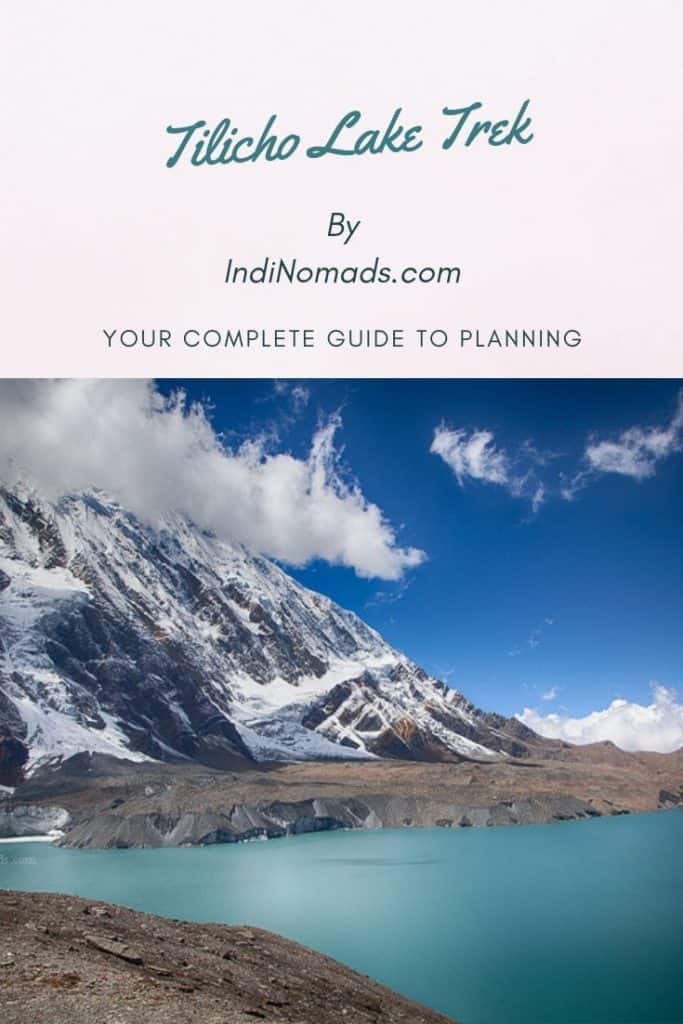
What about you? Have you ever been in a hike that pushed you to the edge that you still think about and wonder how you managed it ?


